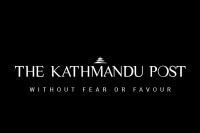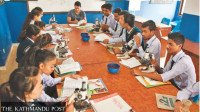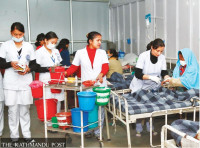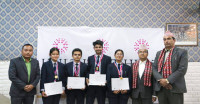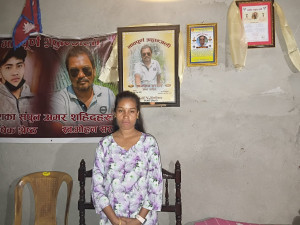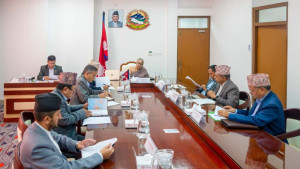Miscellaneous
A new music video breaks social taboos and presents a poignant homosexual love story
Young love is the stuff of many a film and music video. These depictions bank on the idea that love can be relatable to any number of audiences, as everyone has been in love or wants to be in love. But overwhelmingly, these portrayals are heteronormative, in that they present heterosexual relationships, where a boy meets girl. A recent music video, however, breaks that tendency and redefines love outside of these traditional norms.
Asmita Manandhar
Young love is the stuff of many a film and music video. These depictions bank on the idea that love can be relatable to any number of audiences, as everyone has been in love or wants to be in love. But overwhelmingly, these portrayals are heteronormative, in that they present heterosexual relationships, where a boy meets girl. A recent music video, however, breaks that tendency and redefines love outside of these traditional norms.
The music video for Sajjan Raj Vaidya’s Hataarindai, Bataasindai, directed by Nurbu Lama, was released on January 1 on Vaidya’s YouTube channel. Set in New York City, the video’s use of muted colours allows for the visuals to linger even as the audience focuses on the song and storytelling. There are two parallel stories running together, but not necessarily in chronological order, and there is a poignant twist.
As the video begins, a girl and a boy are each getting ready in their own spaces, both rushing out of their apartments to subway platforms. But halfway through the video, the audience realises that they are looking to meet their respective lovers and not each other—one heterosexual and the other, a homosexual couple, both equally in love and in rush—Aaunu ma kaha timi maya, hataarindai, bataasindai (come to me my love, rush like the winds).
In the video, the homosexual romance is never awkward, abrupt or preachy. It arrives and transitions effortlessly, as if this were just any other relationship. At first, the video lures the audience in with a traditional relationship, but at its own tender pace, it simply tells the story of love and its celebration, transcending social norms.
The story isn’t complicated at all, in fact the director seems more inclined towards capturing the simpler things in life, almost mundane everyday activities like getting ready and commuting. The actors too have minimal or no make-up and are wearing everyday outfits. With such a simple approach, it almost feels like the video is challenging the traditional perception of ‘normalcy’, presenting the story of two homosexual men by beautifully avoiding stereotypes and establishing that their love and relationship is as valid as any heterosexual one.
One of the most powerful moments in the video is an unabashed kiss scene between the two men. The actors, Jonsai Thapa and Arhant Shrestha, deliver what is arguably the best kiss ever seen on Nepali screens. Until that scene, the video is all about subtlety, but when the two men fall into each other’s loving embrace and kiss unashamed in the middle of Grand Central Terminal, it is almost as if the video is exploding, abandoning restraint and giving into passion.
The cinematography is basic yet powerful. The simplistic storytelling spills through the use of camera angles as well. The point-of-view shots help the audiences understand the narrative further, along with indulging in a spectrum of emotions, taking the audiences on a ride through the highs and lows of the characters’ emotions in sync with the music. To accomplish this in a little less than six minutes is a feat in itself.
There is nothing unnecessary in the video—the characters, outfits, train rides or even a prop as simple as a camera held by one of the actors. The end credits rolls the footage from that same camera, further displaying the director’s meticulous thought process.
The only reservation with this music video is its setting in a foreign city. What the video is trying to accomplish would probably have been more impactful if it had been set in a Nepali city. Locating a story as bold as this inside Kathmandu would’ve allowed its message to resonate better with Nepalis.
Nepal has rarely seen such a frank depiction of homosexuality. Although Soongava, a 2012 feature film directed by Subarna Thapa, explores the tribulations of a lesbian couple, there have been very few mainstream films or videos that have gay or transgender characters that are not stereotyped or used for comic effect. While Soongava portrays a lesbian romance, a similar treatment with gay men seems almost impossible, especially given the patriarchal conception of masculinity in Nepal. After the video was released, many Nepalis, including members of the LGBTIQ community, took to social media to express their appreciation.
Lex Limbu, a celebrity blogger based in the United Kingdom, thanked Vaidya and his team for supporting the ‘larger community’ in a blog post. Ever since coming out on February 24, 2018, Limbu has been a vocal advocate for gay rights and has supported other Nepali men’s coming out stories too.
The music video, which has already garnered more than 380,000 views in just four days, has certainly provided visibility to the stories of homosexual couples. Following Vaidya’s rising popularity among the youth through hit singles such as Mooskan and Hawaijahaj, with this new music video, young gay men and women have a beautiful video to relate to.
Nepal has been relatively open towards the LGBTIQ community through policies in recent years but unforgiving social taboos still prevent sexual minorities from living openly. They are often subject to bullying and ostracisation—a line from Vaidya’s song—Timro ra mero, hamro katha ko sirsak dhairya banisakechha (yours and mine, our story has been titled patience)—aptly describes the struggles of the gay community to become accepted, acknowledged and respected.
Manandhar tweets @asmitamdr




 22.12°C Kathmandu
22.12°C Kathmandu.jpg)

